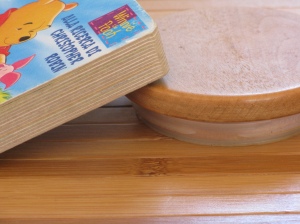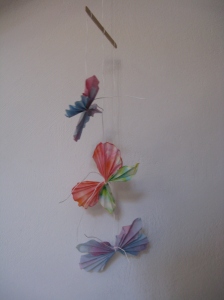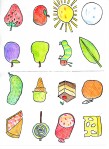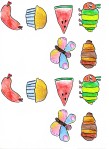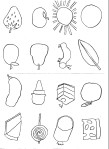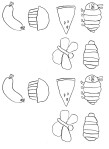Per leggere questo post in italiano, cliccate qui.
The Very Hungry Caterpillar by Eric Carle is one of our favorite stories – (you can see by how many times we’ve posted about it under categories to your right). It has the some of the very important features to look for when reading to ESL or EFL kids – the story uses a fairly simple and basic language, the story is interesting and the pictures explain the what is happening even if the kids don’t understand many of the words. This story is also adaptable to teach different topics- the life cycle of a butterfly (also order- first, second, next etc), days of the week, counting and food. We focused on the life cycle of a butterfly for our project. We made mobiles and this is how we did it: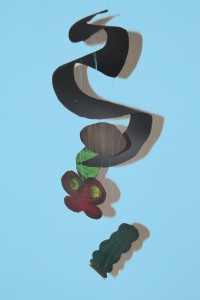 Supplies:
Supplies:
- paper plate (or construction paper and something to trace a circle)
- black construction paper
- a white or light colored pencil
- crayons or oil pastels
- scissors
- large embroidery needle and thread
First take the paper plate and draw a large spiral shape and cut it out.

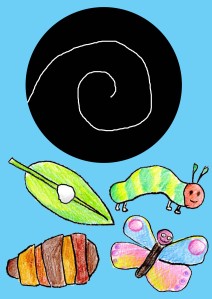 Use the white pencil to draw an egg on a leaf, a caterpillar, a cocoon and a butterfly (we folded the paper in half and drew on the fold). (The kids were given 12 x 12 cm squares and asked the kids to draw as big as they could – otherwise they tended to draw something small in the center of the paper – making it hard to color, cut out and see). The drawing above is not to scale, but just to give you an idea of what the pieces you should have.
Use the white pencil to draw an egg on a leaf, a caterpillar, a cocoon and a butterfly (we folded the paper in half and drew on the fold). (The kids were given 12 x 12 cm squares and asked the kids to draw as big as they could – otherwise they tended to draw something small in the center of the paper – making it hard to color, cut out and see). The drawing above is not to scale, but just to give you an idea of what the pieces you should have.
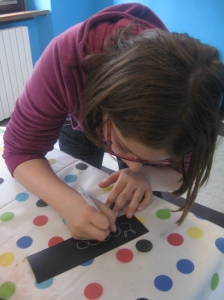 Cut out the pieces and color them in.
Cut out the pieces and color them in.
 This part may require adult supervision – cut out 4 pieces of thread about the same length (about 25 cm) and 1 longer thread (about 40 cm). Thread the needle with the large piece of thread, poke the needle through center of the spiral (going from top to bottom) and then poke it back through again (going from bottom to top). Tie a knot at the end. This will be used to hang the mobile.
This part may require adult supervision – cut out 4 pieces of thread about the same length (about 25 cm) and 1 longer thread (about 40 cm). Thread the needle with the large piece of thread, poke the needle through center of the spiral (going from top to bottom) and then poke it back through again (going from bottom to top). Tie a knot at the end. This will be used to hang the mobile.
Now attach the other pieces. Using the shorter pieces of thread poke the needle through the top of the spiral, poke it though one of your pieces (leaf, caterpillar, cocoon or butterfly), poke it back up through the spiral and tie a knot. Repeat, making sure you evenly space each piece. The order doesn’t really matter because it changes as the mobile spins.
Here is a cute little song to sing (to the tune of Up On The Rooftop) while you are working:
- First comes a butterfly and lays an egg.
Out comes a caterpillar with many legs.
Oh see the caterpillar spin and spin,
A little chrysalis to sleep in.
- Oh, oh ,oh wait and see!
Oh, oh, oh wait and see!
Out of the chrysalis, my oh my,
Out comes a beautiful butterfly!
(We didn’t make it up, but since we’ve seen it on many other sites, we can’t cite it since we don’t know who to give the credit to – but nice job whoever it was!)









